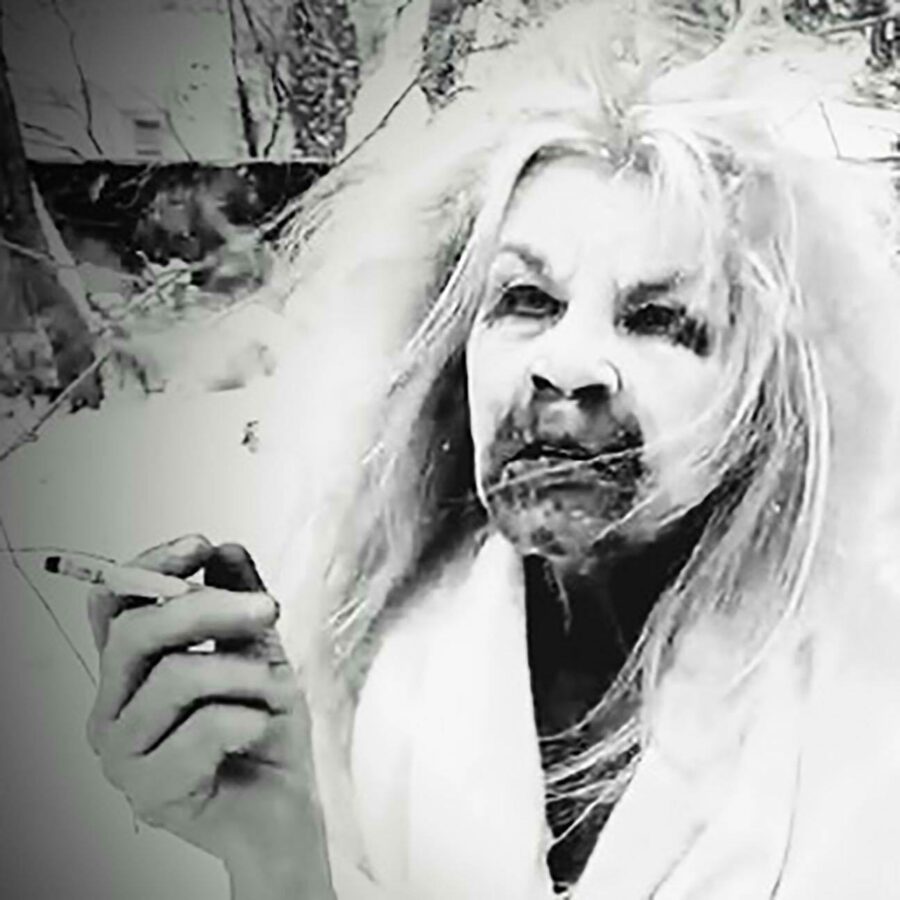
Susan Aydan Abbott, Crone 1, digital print, 2022
Some years ago, I stood in front of William Kurelek’s painting I Spit on Life[1] and recalled that he had denied having a mental illness when he painted it. Instead, he said, he had been having a spiritual crisis. Looking at the image, a monumental rendering of suffering to which I felt powerfully drawn, his assertion seemed ludicrous to me. With Hieronymous Bosch-like extremity, Kurelek had depicted torture, self-mutilation and suicide. How could he have been anything but mentally ill?
Eleven years later, I have a very different perspective. I know now what it’s like to have other people’s notions of my madness supplant my own; who am I to supplant Kurelek’s?
“Madness,” for me, has meaning that lives in layers. It means recapturing my power to choose how to live my differentness. It means clearing away the biomedical frameworks of illness that have been used to stake claims on my mind. It means knowing this is a political act, and that mad people have been doing this for a long time.
I see myself as a mad artist blithely trampling the carefully curated gardens of the Academy and the thorny roses of the medical Colleges. I just want to make art and, like any artist, make it my own way, but galleries are fraught places for mad people.
There is a sordid historical collusion between psychiatry and art’s haut monde. Since the early 20th century, collections of artwork by insane asylum inmates have been thought of as a kind of worm-hole into the human psyche, rather than as art. Hospital museum curators (who tend to be psychiatrists) and contemporary artists alike continue to perpetuate sanist tropes about mad art and experiences of madness. As one documentary opines about the artists of the Prinzhorn Collection (many of whom were gassed to death in Nazi Germany), “Each of these people is a hidden universe requiring a key.”[2]
Art by “mentally ill” artists continues to be understood and evaluated as therapeutic, rather than aesthetic; it’s more attributable to impulse and pathology than to skill. The art academy’s disdain for art therapy devalues and shuts out mad artists and implies that their work, as crazy people, results from an illness that the artist can scarcely take credit for.
Who, then, gets to tells us what it is to be mad, to be differently-minded? Psychiatry and psychology practitioners are obviously regarded as the go-to experts. The Museum of the Mind website observes that the psychiatrist of one artist, Joan Gunther, “seems to be placing his own views in the notes rather than Joan’s, and it can be quite difficult to tell whose view has been noted down.”[3] We also turn to non-mad artists of all disciplines for portrayals of asylums, madness and psychiatric treatments, often rife with depictions of demented doctors, criminally insane inmates and vengeance-seeking spirits.
This stands in stark contrast to the needs of mad artists to articulate the contested mind. “A considerable body of scholarship has already demonstrated that the individualization and medicalization of social problems are at the heart of psychiatry,”[4] according to researcher Jasna Russo. Artist Hanan Hazime describes how, as a Muslim woman, her emotional responses to real danger have been seen by mental health care providers as a sign of mental illness. Standardized assessments for psychiatric illnesses lack cultural insight, she says. “It looks different for me.”[5]
Susan Aydan Abbott is a graduate of MAWA’s 2018 Foundation Mentorship Program. She explains that institutions need to be able to adapt to the needs of artists with mental illness and hidden disabilities, and provide flexibility with time restraints, fluctuating moods and space to “do me, unfiltered, unexplained.”[6]
Aydan Abbott and Hazime both express concerns about tokenism. Hazime notes the irony in an offer she received from a gallery to comment publicly on its diversity and inclusion, but not to exhibit her work. “I just want to show my art,” she observes wryly. “My art can speak for itself.”[7]
True accessibility requires the art establishment to confront the financial, social and biomedical policing of mad, intersectional lives. Maybe you will think me crazy if I propose that mad artists should be funded, rather than our projects; that mad art should be recognized as a discipline (or perhaps an “undiscipline”); and that we need to lead rather than being merely included, like that awkward kid your mom made you invite to your birthday party. We need to throw our own parties.
Perhaps the tallest order is the simplest one: for mad artists to be accepted as the authors of our experience. As the authors of “Mobilizing Mad Art in the Neoliberal University” put it, “the most exciting possibilities occur when we take up art as process[8] through which we open up, provoke, defy and resist ahistorical and apolitical approaches to madness.”[9]
[1] The painting can be accessed online as part of the 2011 Kurelek retrospective, The Messenger (which incidentally illustrates the interpretation of mad art as “therapy”).
[2] Between Insanity and Beauty – The Art Collection of Dr Prinzhorn. Written and directed by Christian Beetz, Gebrueder Beetz Filmproduktion, 2007.
[3]Retrieved from https://museumofthemind.org.uk/blog/joan-gunther, September 1, 2022.
[4] Russo, J. (2022) "De-psychiatrizing our own research work." Front Sociol, 7:929056. doi: 10.3389/fsoc.2022.929056
[5] Hazime, Hanan. Interview. Conducted by Lisa Walter. 1 September 2022.
[6] Aydon Abbott, Susan. Interview. Conducted by Lisa Walter. 1 September 2022.
[7] Hazime, Hanan. Interview. Conducted by Lisa Walter. 1 September 2022.
[8] Emphasis is mine.
[9] Reid, J., Snyder, S.N., Voronka, J., Landry, D., and Church, K. (2019). "Mobilizing Mad Art in the Neoliberal University: Resisting Regulatory Efforts by Inscribing Art as Political Practice." Journal of Literary & Cultural Disability Studies 13(3), 255-271. https://www.muse.jhu.edu/article/731353.
Lisa Walter is an undisciplinary artist and social change educator based in Treaty 1 territory/Winnipeg. She is delighted to have graduated from the 2021/22 Foundation Mentorship Program.

